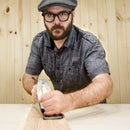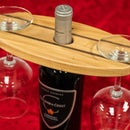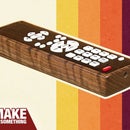Introduction: Fake Corner Cabinet
A fairly basic woodworking project with a rectangular case and a large top that fits into a corner of your room. You can get more details about the build including the tools and supplies used as well as a free detailed PDF plan at my website.
Step 1: Cutting Cabinet Shell
Cut to width and length the 5 boards that will make up the cabinet.
(2) Sides - 9" x 44" x 3/4"
(3) Centers - 8 3/4" x 22” x 3/4"
Step 2: Cutting Dados
On the two side pieces you’ll want to cut three 3/8" deep dados to accept the center pieces. You’ll want to set the width of your dado to the exact thickness of your plywood. It’s recommended to cut the dados in scrap wood to test fit the pieces.
The lowest dado is 3/4" up from the bottom, the center dado is 10 1/4" up from the bottom and the top dado is flush with the top.
Step 3: Glue Up Cabinet
Next you’ll glue up the five boards with some yellow glue and clamps. Make sure everything is square as you tighten the clamps.
Step 4: Cutting Face Frame
The face frame will cover the exposed edge of the plywood cabinet and give us something to attach the doors to. Start by cutting to width and length the five pieces that’ll make up the face frame.
NOTE: The center pieces are 3/16" longer than what they need to be. This will make the face frame slightly larger than the case which we’ll flush down at a later step. This will give us some “wiggle room” as we attach it to the case.
(2) Face frame stiles - 44" x 1 3/4" x 3/4"
(3) Face frame rails - 19 7/16" x 1 3/4" x 3/4"
Step 5: Assembling Face Frame
Now you can glue and screw your face frame together. I prefer using pocket hole screws on the back of the frame. It makes for quick work and the pocket holes will not bee seen since the backside of the frame will be glued to the cabinet.
Step 6: Gluing on Face Frame
Next you can glue the face frame right to the cabinet. If you use plenty of glue and clamp it correctly you wont need any other reinforcements. Some woodworkers like to add biscuits or pocket hole screws but in my experience it’s not necessary.
Step 7: Flush Trim Face Frame
Using a flush trim bit with the bearing on the bottom, clean up the overhang of the face frame. The bearing will ride along the cabinet while the bit only removes material from the face frame and leaves a near perfect surface.
Step 8: Cutting Pieces for Doors and Drawers
Cut all the door and drawer parts to width and length out of solid walnut.
(4) Door stiles - 31" x 1 3/4" x 3/4"
(4)Door rails - 6 7/16" 1 3/4" x 3/4" (includes 1/4" tongue)
(2) Drawer stiles - 7 1/4" x 1 3/4" x 3/4"
(2) Door rails - 16" 1 3/4" x 3/4" (includes 1/4" tongue)
Step 9: Cutting Grooves
All 12 pieces will receive a 1/4" deep and 1/4" wide groove cut right down the center. This will accept the tongues on the mating pieces as well as the door glass and drawer panel.
Step 10: Cutting Tongues
All the rails will have a 1/4" tongue that will fit into the mating groove. Cut this in some scrap to test the fit. Watch the video for a demonstration.
Step 11: Gluing Up Doors and Drawer
Next you can glue up the drawer and the doors. For the drawer you will need to cut a 1/4" sheet of plywood down to fit. You can leave the door panels empty for now.
(1) Plywood panel - 16" x 4 1/4" x 1/4" (approximate, cut to fit)
Step 12: Routing Rabbet for Glass
With a rabbeting bit mounted in your router you can then route a rabbet on the backside of your door panels to accept the glass.
Step 13: Cutting the Drawer
Cut the drawer pieces from 3/4" plywood with a 1/4" groove cut into to accept a 1/4" sheet of plywood for the bottom. The width of your drawer needs to be 1" smaller than the opening of the face frame. This will allow for 1/2" thick drawer slide on each side. The bottom panel measurement is approximate and should be cut to fit.
(2) Front / Back - 16 3/4" x 5 1/2" x 3/4"
(2) Sides - 8 3/4" x 5 1/2" x 3/4"
(1) Bottom - 17 1/4" x 7 3/4" x 1/4" (approximate, cut to fit)
Step 14: Assembling the Drawer
Now you can glue and clamp the drawer together using wood glue. Notice in the photo that the front and back sit on the inside of the sides.
Step 15:
Now you can attach the doors to the cabinet with the hinges of your choice. There are many types of hinges and for this project I chose to use brass butt hinges. You can watch a video on how to install butt hinges here.
Step 16: Installing Drawer Slides
Before installing the drawers you will need to build-out the insides of the cabinet so your drawer slides are flush with the face frame. I used some 2x4 lumber and planed them down, glued them to the sides and mounted my drawer slides.
With the drawer slides attached to the cabinet you can now attach the slides to the drawer. Place a couple of shims underneath the drawer just so it doesn’t rub along the bottom and screw it in place.
Step 17: Installing Drawer Face
Then you’ll add some wood glue to the back of the drawer. A good tip is to add some hot glue into the corners as a temporary clamp. Also it’s a good idea to use a deck of playing cards to ensure an even gap all the way around. Once the hot glue cures you can open the drawer and add some clamps.
Step 18: Making the Top
To cover the edges of the plywood you can purchase edge banding or make your own like I did. I cut some very thin strips of walnut on the tablesaw and just glued and taped into place. To attach it to the cabinet, just pre-drill and screw it down from underneath.
Step 19: Attaching the Back
Now you can tack on the back of the cabinet with some brad nails.
(1) Plywood Back - 22" x 44" x 1/4"
Step 20: Adding Glass to the Doors
The door panels can be whatever you like! I had my local glass supplier cut some glass to size and I have it backed with these 1/4" plywood panels. Everything is held into place with window screen clips.
(2) Glass - 6 7/16" x 28" x 1/8"
(2) Plywood backing - 6 7/16" x 28" x 1/8"
Step 21: Cabinet Feet
The last steps are to add feet, a finish and some shelf pin removable shelves. The feet are just some walnut scraps I glued into place and for the most part are not visible but I like how it “lifts” the cabinet off the ground. I used one coat of boiled linseed oil followed by 3 coats of satin polyurethane.
Step 22: Matching Cabinet
One cabinet has glass doors and the other cabinet was made to hold my rack mountable music gear. You can get the free detailed PDF plans for this woodworking project by signing up for my email list at my website. You'll also find all the supplies and tools I used on my website.













